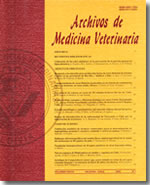Biochemical profile of the Gluteus medius muscle in horses with different performance records
Main Article Content
Abstract
Biopsies from three different depths of the Gluteus medius muscle were obtained from 36 endurance horses, aged 8.42 ± 2.85 years and of both sexes. Twenty of the horses were considered excellent performers according to the mean speed of their three fastest records in endurance events, two or three years prior to the study. The other 16 horses were considered moderate performers, with a mean racing speed <12.5 km/h (in 120- to 180-km endurance rides), <14 km/h (in 80- to 120-km endurance rides), or <13.5 km/h (in 40- to 60-km endurance rides). The activities of citrate synthase (an indicator of the citric acid cycle activity), 3-OH-acyl-CoA-dehydrogenase (a marker for lipid oxidation) and lactate dehydrogenase (an indicator of anaerobic metabolism) enzymes were also studied. Significant differences in oxidative enzyme activities but not in the glycolytic lactate dehydrogenase enzyme activities were recorded between performance categories. Excellent performers had higher activities of citrate synthase (P<0.001) and 3-OH-acyl-CoA-dehydrogenase (P<0.02) enzymes than the poorest. The three enzyme activities changed significantly with the increase of sampling depth within the muscle. Citrate synthase and 3-OH-acyl-CoA-dehydrogenase activities increased by 60% and 75%, respectively, and that of lactate dehydrogenase decreased by 23% from surface to deep sampling depths. When lactate dehydrogenase/citrate synthase and lactate dehydrogenase/ 3-OH-acyl-CoA-dehydrogenase enzyme activity ratios were regressed on sampling depth in order to describe the general metabolic profile of the muscle, a strong linear relationship was found in both performance groups (P<0.001). The highest intercepts of these regression lines, found in moderate performers when compared to excellent performers (P<0.001 and P<0.01 for both ratios), clearly show that the best performing endurance horses have a greater aerobic capacity and a relatively lower anaerobic capacity in the Gluteus medius muscle than those horses that have been moderately endurance raced. These results show that fibre metabolic profile of this muscle is directly related to the athletic ability of the horse for endurance events.

